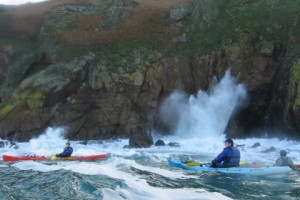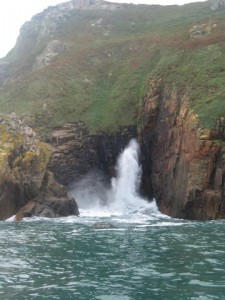Blow holes on the north coast of Jersey.
A short sea kayaking video with a couple of the blow holes near L’Ile Agois and Greve de Lecq, Jersey. This section of coast has some large caves and numerous blow holes which work well when the conditions are right. At times theses blow holes can blow up to 30ft high.
As you head East look out for some ropes and even a ladder running down the cliff faces. Fishing in Jersey can be classified as an extreme sport. I often spot fishermen heading down the cliff face to fish some good spots.
Swell and tide streams around Greve de lecq
The main problem when sea kayaking out of Greve de Lecq is the swell. On the flood tide the Easterly tide stream allows the swell to get through. Plus, the rising tide probably allows the swell to pass over the reefs further offshore.
In contrast, within half an hour of the start of the west going tide stream I’ve seen the swell start to drop off as the strength of the flow builds up and acts as a barrier to the swell arriving from the West.
L’Ile Agois
L’Ile Agois (in the latter part of the video) is a small island. It was excavated in the 1950’s and the 1970’s. Large quantities of Iron Age pottery were found from a time when the island was probably still connected to Jersey around 9th century BC The hollow remains of 27 circular huts and 2 rectangular buildings were found. It is suspected the site might have included a small community of hermit monks. Seven coins of Charles the Bald who died in 877AD have been found here which indicate that the island was probably re-inhabited again about 1800 years later.
The large narrow channel running between the rocks can be paddled providing you get your timing right and the swell is not too big….
The path down to the beach at L’Ile Agois is now in very poor condition but I still bump into a few elderly people who are prepared to head down to one of the most isolated spots on the north coast of Jersey. Personally I prefer to paddle into the bay. Look out for the ladders and remains of a bridge on the cliff path into the bay. This was installed by an SAS TA engineering team many years ago as part of a training exercise.


